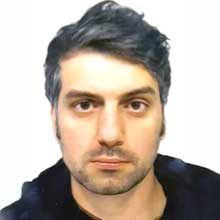
Simone DILARIA
- Position
- Adjunct Professor
-
simone.dilaria@unive.it
- Website
-
www.unive.it/people/simone.dilaria (personal record)
Simone Dilaria earned a Master’s degree in Archaeological Sciences in 2014 and a Postgraduate Diploma in Archaeological Heritage in 2016. In 2020, he was awarded a PhD with distinction in History, Criticism, and Conservation of Cultural Heritage from the University of Padua, and subsequently he was a Post-Doc Research Fellow at the Department of Geosciences and the Department of Cultural Heritage at the same university. From February 2022 to January 2025, he held a position as a Fixed-Term Assistant Professor (RTD-A) in Classical Archaeology (SSD L-ANT/07) at the University of Padua. Simone Dilaria is currently a research fellow (SSD GEOS-01/D – Mineral Resources and Mineralogical-Petrographic Applications for the Environment and Cultural Heritage) at the Department of Cultural Heritage, University of Padua. Since September 2025, he has also been serving as an Adjunct Professor at Ca' Foscari University of Venice (SIE – International School of Higher Education).
Between 2021 and 2022, he was also a Research Fellow at the Laboratory of Archaeometry, University of the Peloponnese (Greece), in 2024, Visiting Professor at Venice International University (VIU). In 2025 he obtained a Marie Curie Seal of Excellence under the MSCA-PF 2024 – Global Fellowship call.
He holds the National Scientific Qualification (ASN) for Associate Professor (10/A1 – Archaeology) and has served as Principal Investigator for three funded research projects:
- MoReS: Unveiling Modern Restorations in Pompeii. A Novel Tool to Solve the Vesuvian Heritage Conservation Dilamma (developed at Department of Cultural Heritage, University of Padova), funded By Gerda Henkel Foundation, 2025
- ARISTEAS: Investigation of Pozzolanic Products in Ancient Lime-based Binders and Glasses (University of the Peloponnese, Laboratory of Archaeometry, 2021–2022), co-funded by the European Regional Development Fund (ERDF), the European Social Fund (ESF), and the Greek Ministry of Development.
- UNIPD-SID: Trade and Use of Volcanic Pozzolans in the Roman World (University of Padua, Department of Cultural Heritage, 2023), funded under the University of Padua’s BIRD 2023 research program.
His research combines archaeological fieldwork with advanced laboratory analysis, focusing on ancient coonstraction and decorative materials — including mortars, pigments, stones, and plasters — through techniques such as Raman spectroscopy, X-ray diffraction, optical and electron microscopy, XRF (and pXRF), and (LA)ICP-MS. His main areas of expertise include ancient production technologies, provenance studies, and scientific dating methods such as radiocarbon and optically stimulated luminescence (OSL). He is member and contributes into several research projects with italian (University Ca' Foscari of Venice, University of Udine, Verona, Siena, Federico II in Naples) and international (University of Notre Dame - USA; University of Lausanne; University of Haifa; MHAS Museum of Croatian Archaeological Monuments in Split; University of Regensburg; Slovenian Geological Service) research institutions
He is actively involved in fieldwork coordination for archaeological missions of the University of Padua in Aquileia (Udine) and Nora (Cagliari).
He has authored or co-authored over 60 scientific publications, including articles in ANVUR A-rated and internationally peer-reviewed journals (ISI), and a monograph on archaeometric approaches to ancient mortar materials. His H-index is 10 (Scopus), 8 (Web of Science), and 11 (Google Scholar). He attended as speaker or invited speaker at several national and international conferences and serves as a peer reviewer for journals such as Scientific Reports, Journal of Archaeological Science, Archaeometry, and Journal of Roman Archaeology. He serves as Associate Editor for the scientific journal Archaeological and Anthropological Science.
The information above have been uploaded on Ca' Foscari website direclty by the user this webpage refers to. The correctness and truthfulness of the published information are responsibilities of the relevant user.
